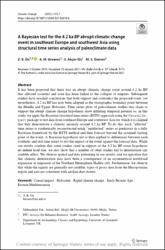| dc.contributor.author | Ön, Zeki Bora | |
| dc.contributor.author | Greaves, Alan | |
| dc.contributor.author | Akçer Ön, Sena | |
| dc.contributor.author | Özeren, M. Sinan | |
| dc.date.accessioned | 2021-03-18T06:25:28Z | |
| dc.date.available | 2021-03-18T06:25:28Z | |
| dc.date.issued | 2021 | en_US |
| dc.identifier.uri | https://doi.org/10.1007/s10584-021-03010-6 | |
| dc.identifier.uri | https://hdl.handle.net/20.500.12809/9033 | |
| dc.description.abstract | It has been proposed that there was an abrupt climatic change event around 4.2 ka BP that affected societies and even has been linked to the collapse of empires. Subsequent studies have reached conclusions that both support and contradict the proposed event; yet nevertheless, 4.2 ka BP has now been adopted as the stratigraphic boundary point between the Middle and Upper Holocene. Time series plots of paleoclimate studies that claim to support the abrupt climate change hypothesis show differing temporal patterns so, in this study, we apply the Bayesian structural time series (BSTS) approach using the CausalImpact package to test data from southeast Europe and southwest Asia for which it is claimed that they demonstrate a climatic anomaly around 4.2 ka BP. To do this, each “affected” time series is synthetically reconstructed using “unaffected” series as predictors in a fully Bayesian framework by the BSTS method and then forecast beyond the assumed starting point of the event. A Bayesian hypothesis test is then applied to differences between each synthetic and real time series to test the impact of the event against the forecast data. While our results confirm that some studies cited in support of the 4.2 ka BP event hypothesis do indeed hold true, we also show that a number of other studies fail to demonstrate any credible effect. We observe spatial and data patterning in our results, and we speculate that this climatic deterioration may have been a consequence of an asymmetrical northward expansion or migration of the Northern Hemisphere Hadley cell. Furthermore, we observe that while the signals are generally not credible, types of proxy data from the Mesopotamia region and east are consistent with aeolian dust storms. © 2021, The Author(s), under exclusive licence to Springer Nature B.V. part of Springer Nature. | en_US |
| dc.item-language.iso | eng | en_US |
| dc.publisher | Springer | en_US |
| dc.relation.isversionof | 10.1007/s10584-021-03010-6 | en_US |
| dc.item-rights | info:eu-repo/semantics/openAccess | en_US |
| dc.subject | Causal impact | en_US |
| dc.subject | Early bronze age | en_US |
| dc.subject | Holocene | en_US |
| dc.subject | Rapid climate change | en_US |
| dc.subject | Eastern Mediterranean | en_US |
| dc.title | A Bayesian test for the 4.2 ka BP abrupt climatic change event in southeast Europe and southwest Asia using structural time series analysis of paleoclimate data | en_US |
| dc.item-type | article | en_US |
| dc.contributor.department | MÜ, Mühendislik Fakültesi, Jeoloji Mühendisliği Bölümü | en_US |
| dc.contributor.authorID | 0000-0002-8684-3476 | en_US |
| dc.contributor.institutionauthor | Ön, Zeki Bora | |
| dc.contributor.institutionauthor | Akçer Ön, Sena | |
| dc.identifier.volume | 165 | en_US |
| dc.identifier.issue | 7 | en_US |
| dc.relation.journal | Climatic Change | en_US |
| dc.relation.publicationcategory | Makale - Uluslararası Hakemli Dergi - Kurum Öğretim Elemanı | en_US |


















